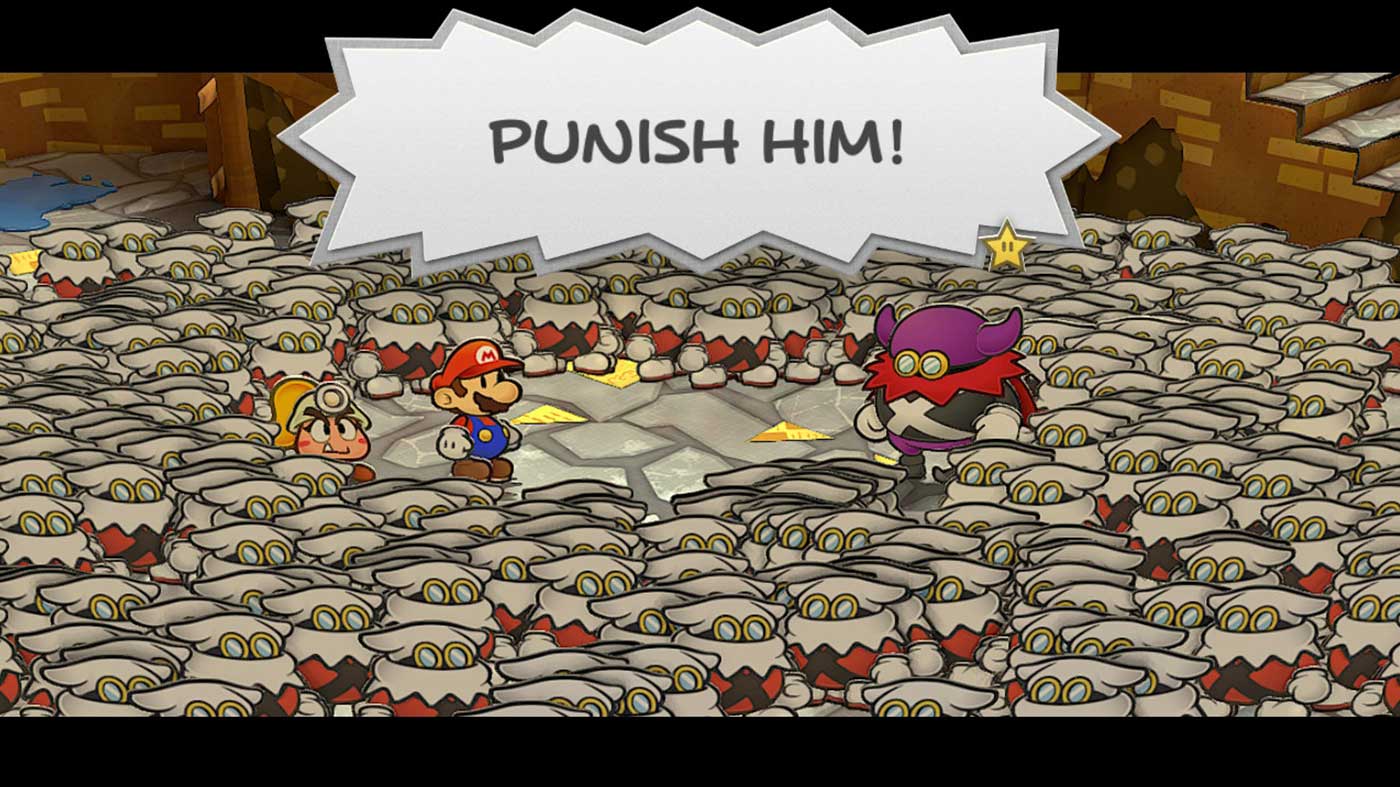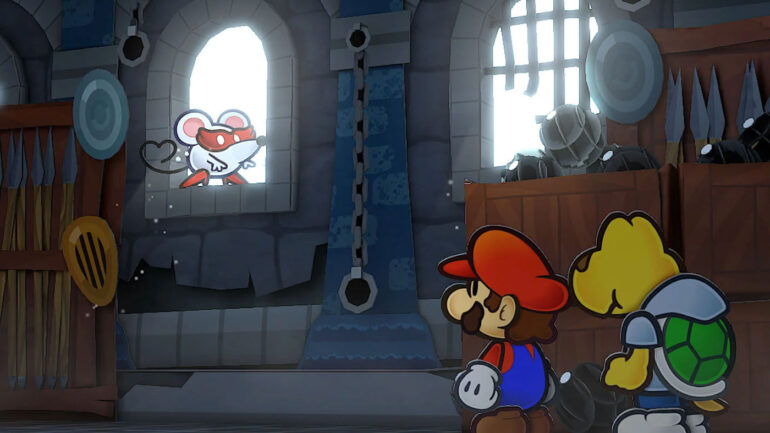For reasons unknown, when Paper Mario: The Thousand-Year Door was released for the Gamecube over two decades ago, I skipped it. I’ve no idea why. I’ve played and enjoyed every Paper Mario game since, but I have been missing the classic RPG feel that the original game had. I’ve often been told that The Thousand-Year Door is the best Paper Mario game, so the remake Nintendo announced last year excited me. But now, having spent considerable time with the game’s first three chapters, it’s easy to see why people love The Thousand-Year Door so much. It’s easily Paper Mario (or even Mario) at its most charming and, more importantly, most playable.
The game begins in Rogueport, a harbour town rebuilt atop the ruins of a city previously destroyed in a cataclysmic event. Since Rogueport was built, rumours abound that the fortunes of this lost civilisation were still hidden underneath the town, behind the titular Thousand-Year Door. Looking to increase her royal wealth, the game opens with Princess Peach exploring Rogueport before coming across a magical treasure map. Excited to find the treasure it leads to, she mails it to Mario, and is subsequently captured by the villainous X-Nauts. Intrigued, Mario eventually heads to Rogueport and picks up where Peach left off.

When originally released, The Thousand-Year Door was lauded for its engaging plot and witty writing. Based on what I’ve seen in the game’s first three chapters, I’m inclined to agree. While previous Mario RPGs have come to be known for their acerbic tone, I was surprised to discover just how self-aware the writers were this far back in Nintendo’s history. Even better, while Peach and Bowser both play secondary roles in the story, their subplots poke fun at the traditional roles they usually play in a Mario narrative.
But enough about the writing – how does a game that’s ostensibly twenty years old play today? Surprisingly well. The game opens with Mario in Rogueport, allowing him to explore the town and discover all the staples you’d expect in an RPG. An item shop, an inn to rest, a place to upgrade abilities and a gaggle of NPCs to interact with. It’s not long before Mario meets the feisty Goombella, a peppy street-smart female Goomba who teams up with Mario after he saves her from danger. She’s also keen to discover the treasure, and the two of them head into the sewers to find the Thousand-Year Door and learn how to unlock it.

Thousand-Year Door will partner Mario with a bunch of characters, and I was privy to see four of them in the opening chapters. Goombella serves as the perfect starter for Mario. She is a student at the local university with a thirst for knowledge, so most of her abilities revolve around telling Mario about the world or gleaning information about enemies. She also behaves slightly similar to Mario in battle too, which is where most of the action happens in Thousand-Year Door.
The battle system in The Thousand-Year Door is turn-based. Mario and one of his partners are pitted against a whole range of enemies from Mario’s storied history. Attacks can be carried out from above (such as Jumping) or from the side (with Hammers or Shells). Enemies are designed so that only some approaches work. Side attacks will miss flying enemies, for example, while spikier enemies can’t just be jumped on. It’s an incredibly simplistic battle system, but that’s hardly detrimental to Paper Mario’s combat. Instead, it’s easy to grasp and much less overwhelming than other games of this ilk.

The crux of your skill comes from timing button presses, stick flicks and the like to maximise your damage. Tapping A, just as Mario or Goombella lands on the enemy, often means another attack will be performed, which will cause more damage. Other times in battle, environmental threats may randomly rear themselves, and buttons must be pressed to dodge them. You can even tap a button at the right time to reduce the damage of an incoming attack, or if you’re brave, tap a different button at the perfect time to dodge the move and do damage back to your attacker.
AMAZON HAS THE CHEAPEST COPY AT $69 WITH FREE SHIPPING
The little elements like this make The Thousand-Year Door’s turn-based battle system more engaging than you’d expect from a game of this era. Mix into this the assortment of partners I was able to recruit in these early chapters, and you’ve got a simple but effective battle system that never gets old. Koops, for example, can withdraw into his shell and take out a row of enemies on the ground. Flurrie can blow enemies out of the stage entirely. Even the baby Yoshi you recruit can swallow enemies and spit them back out at another, damaging two enemies simultaneously.

Each of your partners has uses in the main world, allowing you to explore and find items that can be exchanged for powerful upgrades. It’s less carefully considered than a Metroid game, but some light elements exist. For example, Flurrie can use her wind blow ability to blow pieces of the environment away. At the same time, Yoshi allows Mario to cross larger gaps with his signature flutter jump. The exploration is engaging, and doing so leads to better abilities for both you and your party members, so it feels rewarding, too.
Each chapter of the game has Mario and his team looking for one of the seven stars to help unlock The Thousand-Year Door. There’s a good mix of scenarios here to play through in the early chapters – two of them have dungeons to explore, which feels decidedly old-school, while another has you working your way up a fighters tournament to win the star. The latter, Chapter 3, is particularly interesting. It was initially slightly uninspired, but the great conspiracy-laden plot underneath it made it more engaging than I’d thought it would be.

But that’s where my concern lies with the rest of The Thousand-Year Door. The first two chapters felt well thought out, with a strong dungeon design and interesting puzzles underpinning them. The third chapter feels like a palate cleanser, for sure. Still, its uninspired format has me wondering if The Thousand-Year Door maintains it’s engaging momentum from beginning to end. I haven’t played the original, in case it wasn’t immediately obvious, and won’t just go and search what happens on the internet, but it’s the only real negative of my whole experience after playing these early chapters.
That being said, there are some great little moments where you play as Peach and Bowser separately, exploring their side of the story and doing a great job of shattering the typical roles they play in a story like this. But given that I’ve played so little of their parts, it’s hard to comment on them in this preview.

But what’s immediately apparent is the care and attention that’s gone into restoring this twenty-year-old game into what it is today. The art style in the Paper Mario games was already strong, so a resolution increase was never going to be too dramatic a change from other remakes we’ve seen in the past. But The Thousand-Year Door’s remake treatment feels careful and considered. Everything is bright, crisp and colourful and the new musical renditions enhance the whole experience rather than betraying the spirit of the original. It’s a great visual showcase that performs well, too, and it’s a boon for the game, especially given previous games released late in the life cycle of the Switch.
While I’m only scratching the surface with my time with The Thousand-Year Door remake, it’s shaping up to be one of my favourite games both in the Paper Mario series and on the Switch. The humour is genuinely funny, and the story engages to the point where I can’t stop playing. This is all in great addition to the fact that the game itself is incredibly playable too. After so long, and hearing so many stories, it’s refreshing to discover that The Thousand-Year Door’s reverence can be chalked up to more than nostalgia; it’s, in fact, a genuinely good game. At least so far.

Paper Mario: The Thousand-Year Door launches for Nintendo Switch on May 23rd 2024. You can pre-order it now on Amazon for $69 with free shipping and pre-order price guarantee.



